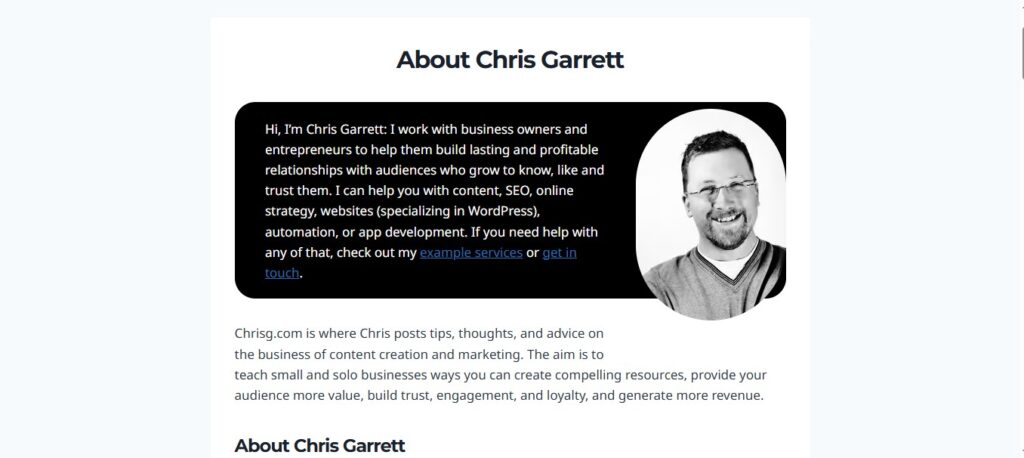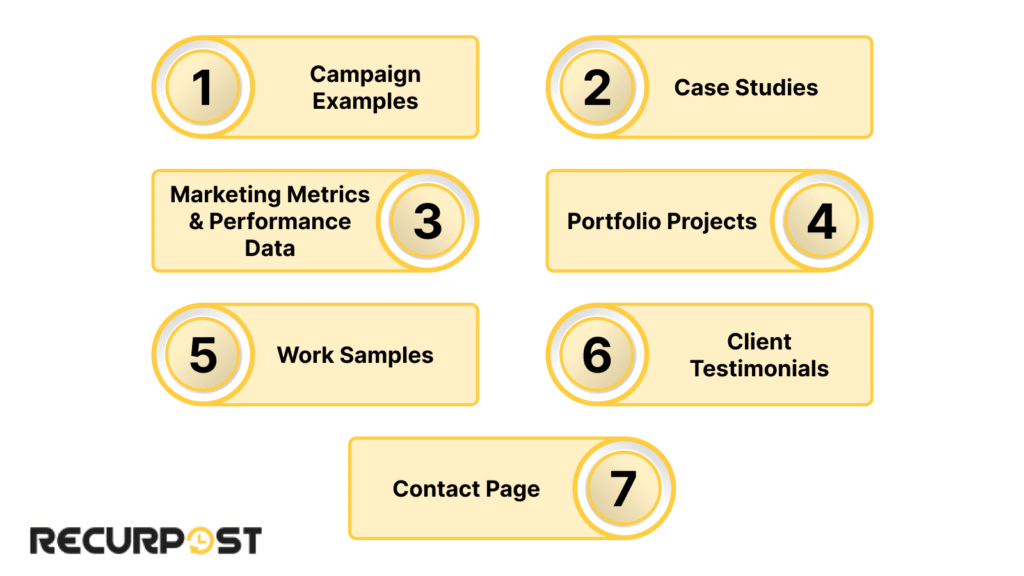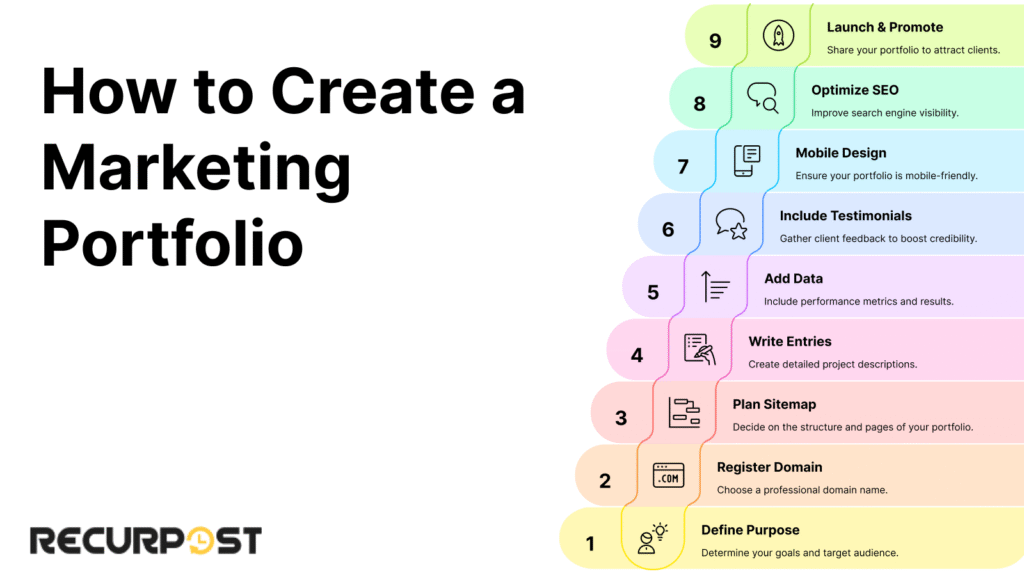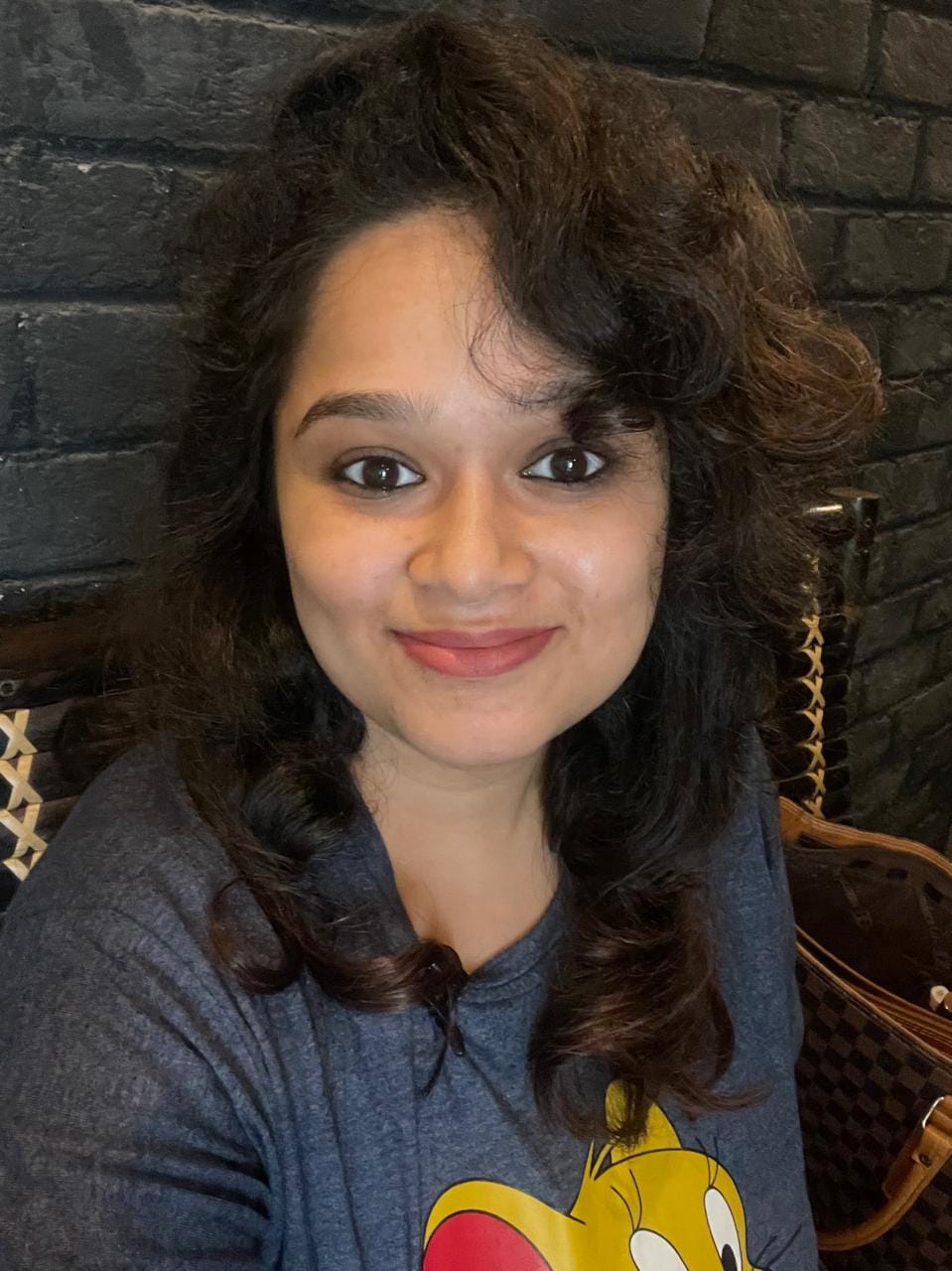Knowing how to create a marketing portfolio matters for marketers and agencies aiming to attract potential clients and show real-world results. In fact, 72% of marketing professionals say a strong portfolio helps attract clients and put marketing strengths front and center.
A solid marketing portfolio shows successful campaigns, work samples, and performance data that prove you can deliver results. It sets you apart from other marketers by showcasing what you’ve built: actual project outcomes, case studies, and professional experience.
More marketers are turning their websites into digital marketing portfolio hubs—central places to present portfolio projects and content examples. Whether you’re into email marketing, social campaigns, or SEO, your portfolio can reflect your skills, brand, and most successful projects.
This post covers how to create a marketing portfolio that attracts clients, shows expertise, and opens doors for freelance projects or job offers.
Why You Need a Marketing Portfolio
Before you create a marketing portfolio, you need to understand the importance of one. A marketing portfolio helps marketers and agencies attract potential clients by presenting their strongest work in one place. It’s more than listing past projects: it’s about sharing marketing wins backed by performance data.
- Shows expertise: Features content marketing portfolio projects, email campaigns, and social media marketing portfolio wins.
- Attracts clients: A clear portfolio helps you stand out with successful marketing projects and relevant campaign examples.
- Demonstrates measurable success: Includes traffic growth statistics, ROI, conversion rates, and engagement metrics.
- Builds your personal brand: Your portfolio website reflects your marketing strengths and style, backed by work samples and client testimonials.
- Boosts job opportunities: A well-structured marketing portfolio draws interest from recruiters, clients, and marketing firms.
- Easy access: Add a dedicated contact page with your contact information for quick client outreach.
Famous Examples of Marketing Portfolios
These marketing portfolios show how professionals use their websites to present campaign examples, personal brands, and digital marketing strengths, especially if you’re looking to create a marketing portfolio that reflects your skills.
Gary Vaynerchuk’s Marketing Portfolio

Gary Vaynerchuk uses his portfolio to feature client campaigns from VaynerMedia, highlight work samples, and build a strong digital presence.
Kathy Kuo’s Marketing Portfolio

Kathy Kuo’s marketing portfolio presents her digital marketing strengths across email marketing, social media content, and SEO performance metrics.
Chris Garrett’s Marketing Portfolio

Chris Garrett’s marketing portfolio features content marketing projects, social campaigns, and a clean layout that makes his work easy to scan. His portfolio includes case studies, professional summaries, and work samples that reflect strong project execution.
7 Key Elements of a Strong Marketing Portfolio

To create a marketing portfolio that works, include the right pieces that reflect your experience and attract potential clients. A strong digital marketing portfolio shares portfolio projects, real results, and clear examples across different marketing channels.
To create a marketing portfolio that stands out and builds your credibility, include these seven core elements: campaign examples across channels, case studies with real outcomes, performance data with measurable results, diverse portfolio projects (including mock work), a range of work samples, client testimonials, and a simple contact page.
1. Campaign Examples
Add 10–15 marketing campaigns showing variety across email marketing, social media content, and content marketing. Include your role, whether strategist, designer, or analyst, to show versatility.
2. Case Studies
Include 3–5 case studies showing campaign goals, your work, and the results. Case studies show how your campaigns solved problems and delivered measurable outcomes like traffic growth or ROI.
3. Marketing Metrics & Performance Data
Add ROI stats, traffic growth, conversion rates, and engagement metrics using tools like Google Analytics or technical SEO. Include lead generation numbers and sales figures when possible.
4. Portfolio Projects
Include client projects and mock portfolio work to show skills across landing pages, ad designs, and social posts. These pieces show creativity and range for real or fictional brands.
5. Work Samples
Add 5–10 work samples to show your ability to write blog posts, build social media strategies, and craft email campaigns. These samples give clients a look at your skills and messaging style.
6. Client Testimonials
Use client testimonials to support your marketing skills and share real client feedback. This builds confidence in your ability to meet goals and deliver results.
7. Contact Page
Add a contact page with your contact details and a clear call to action to reach potential clients. Keep it mobile-friendly and easy to use across devices.
Tools & Platforms to Build Your Marketing Portfolio

To create a marketing portfolio that stands out, use tools that highlight your best work and make it easy for clients to connect. Choose a platform that supports mobile-friendly design, high-quality visuals, and clear navigation for potential clients, making it easier to create a marketing portfolio.
1. Website Builders
AI-powered builders and online platforms make it easy to create a marketing portfolio with a clean layout and consistent branding.
- Wix: Wix’s customizable templates make it simple to create a marketing portfolio using drag-and-drop tools.
- Squarespace: Offers polished templates ideal for portfolios with social media content, graphic design, and branding campaigns.
- WordPress: Gives full creative control for marketers building a marketing portfolio with custom features and plug-ins.
- Weebly: Helps marketers build a marketing portfolio website without any coding knowledge.
2. Behance & Adobe Portfolio
Behance and Adobe Portfolio let social media marketers and content creators share work samples, creative campaigns, and online marketing projects. These platforms are perfect for clean portfolio layouts and discovering what other marketers are sharing.
3. LinkedIn
LinkedIn can double as a place to create a marketing portfolio by featuring work samples and campaign wins. Use your profile to display work samples, client testimonials, and marketing campaign wins. It’s a powerful way to attract new clients and employers.
4. Dribbble & Canva for Design Projects
Use Dribbble and Canva to present visual portfolio projects, from ad designs to social media graphics. These platforms help visual marketers display their creative work clearly and professionally.
5. Google Analytics & SEO Tools
Add Google Analytics data, SEO performance metrics, and conversion rates to show measurable outcomes in your digital marketing portfolio. These tools back up your skills with real numbers.
6. Dedicated Contact Page
Your portfolio website must include a dedicated contact page with your contact details, social media links, and a simple form. This makes it easy for prospective clients to get in touch quickly on any device.
How to Create a Marketing Portfolio

To create a marketing portfolio that works, follow a clear process that helps your best projects and results shine. Build a marketing portfolio by sharing measurable outcomes: case studies, ROI, Google Analytics data, and 10–15 diverse marketing projects.
1. Define Purpose & Audience
Decide who your portfolio is for. Are you targeting freelance clients, hiring managers, or agencies? Choose a goal, such as client acquisition, building your personal brand, or getting job offers.
2. Register a Custom Domain
Pick a domain that fits your brand name or company. A custom domain makes your marketing portfolio website look more professional and easier to share.
3. Plan Sitemap & Portfolio Pages
Decide which pages to include:
- Portfolio Page: Share work samples, portfolio projects, and campaign examples.
- About Page: Add your background, career highlights, and marketing experience.
- Contact Page: Include contact details, a form, and social profile links.
- Blog (optional): Great for content marketers to post insights or recent projects.
4. Write Strong Project Entries
Each entry should cover:
- What the project aimed to solve
- Your exact role
- Measurable results like traffic growth, ROI, or conversions
5. Add Marketing Data & Results
Use performance data to back up your claims:
- Google Analytics insights
- SEO performance metrics
- Lead generation numbers and sales figures
- Engagement metrics and conversion rates
6. Include Testimonials & Case Studies
Add testimonials from past clients or managers. If you’re new, use mock projects or personal work to show your skills.
7. Choose a Mobile-Friendly Layout
Use a responsive template from Wix, Squarespace, or WordPress. Your portfolio should work smoothly across all screen sizes.
8. Add SEO Basics
Use SEO keywords like “social media marketing portfolio” or “email marketing” to help people find your site. Basic SEO improves visibility for potential clients.
9. Launch & Promote Your Portfolio
Once your portfolio is live, continue to create a marketing portfolio that reflects your latest success. Add the link to your social bios and use email marketing to reach new contacts.
Showcase Portfolio on Different Marketing Channels

To create a marketing portfolio that impresses, show your skills across multiple marketing channels and content types. Show your ability to manage campaign examples across content marketing, social media, SEO, and paid ads to create a marketing portfolio that stands out.
1. Social Media Marketing
As a social media marketer, include:
- Posts that boosted engagement
- Campaigns from Instagram, Facebook, LinkedIn, and Twitter
- Content calendars that aligned with client goals
- Traffic and conversion data from social media accounts
2. Content Marketing
A content marketing portfolio should feature:
- Blog posts that improved SEO rankings
- Landing pages optimized for conversions
- Email campaigns with strong open rates
- Web content like product descriptions and homepages
- Traffic growth statistics and sales improvements
3. Email Marketing
Email marketing specialists should include:
- Email campaign work samples with high open or click rates
- A/B testing results showing improvements
- Automated sequences that led to conversions
4. SEO & Digital Marketing
Your SEO & digital marketing portfolio should include:
- SEO audits and keyword research
- Ranking improvements backed by data
- Google Analytics insights tied to traffic and engagement
- ROI and conversion metrics from search marketing efforts
5. Graphic Design & Creative Campaigns
Graphic design projects can include:
- Infographics and ad visuals
- Website layouts focused on user experience
- Social media visuals with branding consistency
- Creative pieces that increased click-through rates
6. Video Marketing
For video marketing, feature:
- Promotional videos that gained attention on YouTube, Facebook, or Instagram
- Video ads that generated conversions
- Branded content that supported messaging goals
7. Paid Media Campaigns
In your paid media campaigns portfolio, show:
- Google Ads or Facebook ad results
- Budget usage and ad spend optimization
- Retargeting campaigns that boosted repeat visits or conversions
By presenting work across these channels, you build a more complete marketing portfolio that attracts clients and showcases your versatility.
Design & Visual Best Practices for Marketing Portfolios
To create a marketing portfolio that makes a strong first impression, design matters as much as content. Use these visual best practices to create a marketing portfolio that’s both clean and client-ready.
- Clean Layout: Keep it simple with a minimalist layout and whitespace that improves focus and navigation.
- Mobile-Friendly Design: Use a responsive layout so your marketing portfolio website works on all screen sizes, from desktops to smartphones.
- High-Quality Visuals: Add sharp visuals like campaign images, landing pages, and ads to support your portfolio projects. These improve engagement and give visitors a quick snapshot of your work.
- Consistent Branding: Stick to one color palette and typography that matches your personal brand and professional summary.
- Readable Fonts: Choose clean sans-serif fonts that support easy reading and a polished look.
- Clear Navigation: Use sections like work samples, contact page, and services page to keep your portfolio organized and accessible.
- Data Visualizations: Add charts showing ROI, traffic growth, or engagement metrics for key marketing campaigns. These visuals turn data into a strong selling point.
- Up-to-Date Content: Keep your portfolio fresh by adding recent work samples and measurable results from successful projects.
Keep It Fresh & Professional
To create a marketing portfolio that stays relevant. Keep it updated with fresh work if you want to create a marketing portfolio that stays relevant and impactful. An up-to-date portfolio shows you’re active in the field and ready to take on new opportunities.
1. Add New Projects and Work Samples
Include portfolio projects, client work, and successful campaigns that reflect your current skills. Regular updates keep your portfolio aligned with what today’s clients want to see.
2. Show Performance Metrics
Add measurable data: SEO rankings, conversion rates, or social media engagement metrics. These numbers prove your campaigns bring real value.
3. Refresh Design and Layout
A clean layout, mobile-friendly design, and easy navigation keep your portfolio modern and user-friendly. Consider design refreshes as your visual brand evolves.
4. Update Your Professional Summary
Your summary should reflect recent wins, new certifications, and current skills. This section is key for clients or employers who want a quick overview of your growth.
5. Keep Contact Details Current
Check that your contact page includes the right email, links to social profiles, and a clear call-to-action. Make it easy for people to reach out.
Conclusion
Create a marketing portfolio that reflects your skills, wins, and work style to stand out in the digital marketing space. A portfolio isn’t just for showing past work—it proves your ability to get results and connect with potential clients.
When your marketing portfolio includes measurable results and stays fresh, it helps attract the right jobs and clients. How do you create a marketing portfolio?
FAQs
1. How many marketing projects should I include?
Aim for 10–15 portfolio projects that reflect your skills in social media, email marketing, and content marketing. Include work samples and campaign examples create a marketing portfolio with measurable results like ROI or traffic growth.
2. Can I add personal or mock projects to my marketing portfolio?
Yes. Personal projects and mock projects help show your range and creativity. Just make sure they align with your professional brand and reflect the type of marketing work you want to get hired for.
3. Should I include a contact page?
Absolutely. Add a contact page with your contact details and a call-to-action so visitors can reach you easily. This turns portfolio visits into client leads or job opportunities.
4. How do I create a marketing portfolio website that stands out?
To create a marketing portfolio, start with a platform like Wix or WordPress. Use a clean layout, readable fonts, and portfolio projects that clearly explain your role and results.
5. What if I have no client work to show yet?
If you’re just starting, focus on mock projects or personal campaigns. These can demonstrate your marketing knowledge, design skills, and ability to create content across different channels.
6. How often should I update my portfolio?
Keep your portfolio current with recent marketing campaigns, new work samples, and updated performance metrics. Regular updates show you’re active and ready for new opportunities.

Ruchi Dhimar is a skilled content writer with 5 years of experience. She is passionate about crafting compelling narratives, specializing in writing content for different industries.





